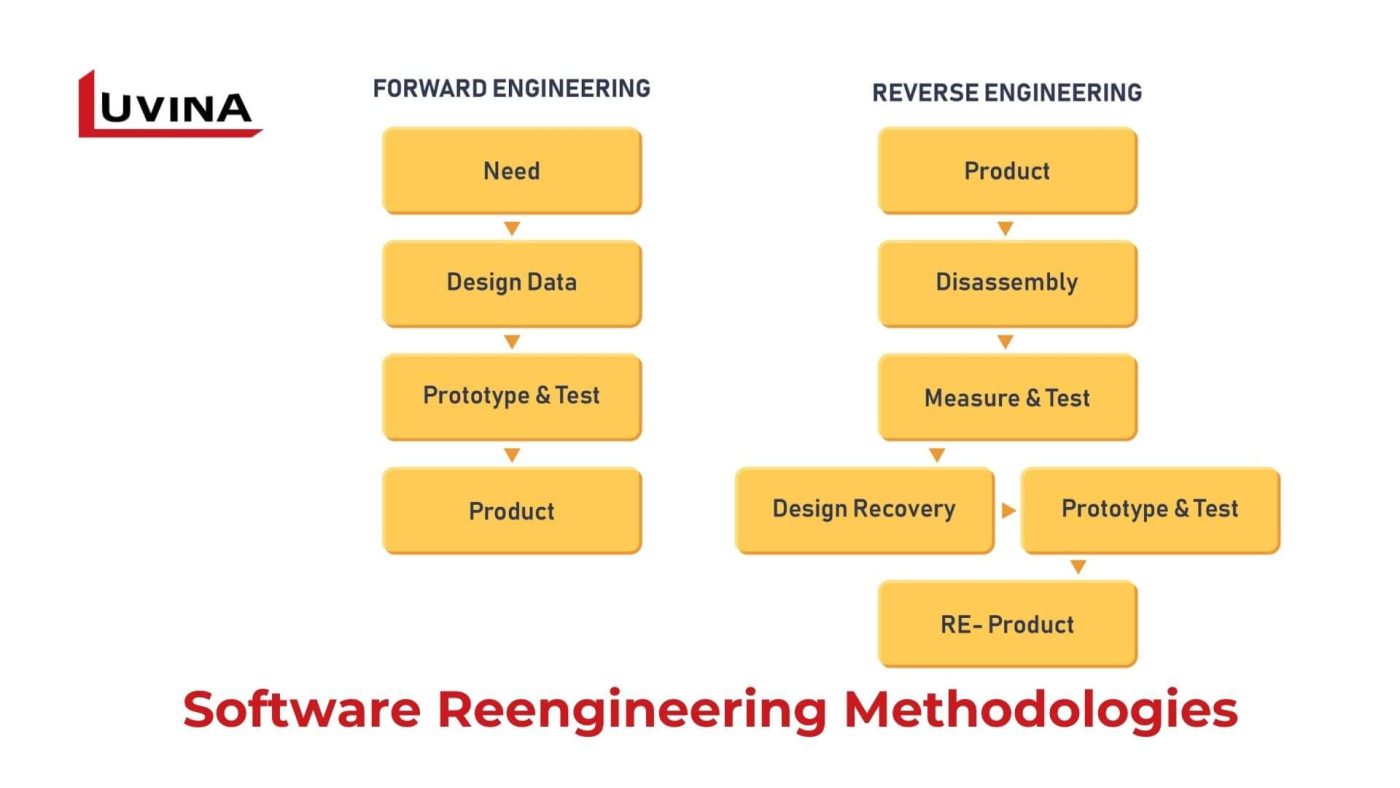Legacy systems form the backbone of many enterprises, representing years of investment and operational history. However, as technology advances, these systems often face challenges in keeping pace with evolving business needs. Software re-engineering emerges as a lifeline for these aging systems, offering a path to rejuvenation and enhanced functionality. In this article, we’ll delve into the critical aspects of software reengineering, exploring its pivotal role in transforming legacy systems to meet the demands of the modern digital landscape.

Understanding Software Re-engineering
Software re-engineering involves the transformation of existing software systems to enhance their functionality, performance, maintainability, or other attributes without altering their external behavior. Its role in revitalizing legacy systems is pivotal. Legacy systems, while robust, often face challenges like outdated technology, inefficiencies, or compatibility issues, hindering their ability to meet current business needs. Reengineering breathes new life into these systems by modernizing their architecture, improving performance, enhancing user experience, and ensuring alignment with contemporary technologies and practices.
Key objectives of software re-engineering include:
Enhanced Performance: Optimizing system performance to meet current demands and improve responsiveness.
Improved Maintainability: Making systems easier to maintain and update, reducing complexities and dependencies.
Integration and Compatibility: Ensuring seamless integration with modern systems and technologies.
Scalability: Adapting systems to handle increased loads or expand functionalities.
Cost Reduction: Minimizing operational costs associated with maintaining outdated systems.
Overall, software re-engineering plays a crucial role in ensuring legacy systems remain relevant, efficient, and aligned with modern business needs, leveraging its objectives and benefits to revitalize these systems for continued and improved functionality.
Signs Your System Needs Re-engineering
1. Outdated Technology
Systems using obsolete technologies or outdated programming languages might struggle to integrate with modern tools or lack support for new features.
2. Poor Performance
Frequent crashes, slow response times, or system downtime are signs of performance issues that could benefit from reengineering for optimization.
3. Difficulty in Maintenance
Complicated code structure, lack of documentation, or challenges in making updates or modifications indicate the need for reengineering to enhance maintainability.
4. Inflexibility or Rigidity
Systems that cannot easily adapt to changing business needs, lack scalability, or face difficulties in accommodating new functionalities.
5. Security Vulnerabilities
Outdated systems might lack security patches or features, making them susceptible to cyber threats or breaches, necessitating reengineering for improved security measures.
6. Poor User Experience
Systems with complex interfaces, limited functionalities, or outdated user interface lead to users’ dissatisfaction.
7. High Operational Costs
Increasing maintenance costs, licensing fees, or challenges in acquiring technical support due to outdated technology.
8. Integration Issues
Difficulty in integrating with newer systems, APIs, or third-party applications due to incompatibility.
Identifying these indicators signals the need for software re-engineering to address underlying issues, modernize the system, enhance its functionality, improve performance, and ensure alignment with current business needs and technological advancements.
Software Re-engineering Strategies
Different approaches and methodologies are employed in software reengineering to revitalize or enhance existing systems. These methodologies vary in their focus, scope, and the extent of changes they bring to the system. Here are a few common methodologies:

1. Reverse Engineering
This involves analyzing the existing system to understand its structure, behavior, and functionality without the aid of comprehensive documentation. It’s often the first step in reengineering to gather insights into the system’s architecture.
2. Forward Engineering
Involves using the insights gained from reverse engineering to create an improved system or application based on modern technologies, best practices, and updated requirements.
3. Component-Based Development
Break down the system into smaller components for reimplementation or enhancement. This approach focuses on reusing existing components or creating new ones to improve the system’s overall structure and functionality.
4. Replatforming
This involves migrating the system to a different platform or environment, such as moving from on-premises infrastructure to cloud-based solutions, to improve scalability, accessibility, and performance.
Regarding the comparative analysis of refactoring, restructuring, and complete system replacement:
– Refactoring: Involves making small, incremental changes to the existing codebase to improve its readability, maintainability, or performance without altering its external behavior. It’s cost-effective and low-risk but may not address deeper architectural or functional issues.
– Restructuring: Focuses on modifying the system’s architecture or design to enhance its scalability, maintainability, or performance. It involves significant changes to the system’s structure and may address architectural issues but could be more time-consuming and complex than refactoring.
– Complete System Replacement: Involves building a new system from scratch while retaining the original system’s specifications. This approach ensures modernization and aligns with current requirements but is time-consuming, expensive, and carries a higher risk of project failure due to the complexity of starting anew.
Each approach has its advantages and drawbacks, and the choice depends on the specific needs, goals, budget, and time constraints of the reengineering project. Refactoring and restructuring focus on improving the existing system, while complete system replacement ensures a more radical overhaul and modernization but with higher associated risks and costs.
>> Also read: A Comprehensive Guide to Types of Cloud Migration
Steps in the Re-engineering Process
The software reengineering life cycle involves several distinct phases, each crucial for successfully revitalizing or enhancing a software system.
1. Planning Phase
– Objective Definition: Identify the goals and objectives of the reengineering effort, including improving performance, enhancing functionality, or addressing security concerns.
– Resource Allocation: Allocate necessary resources, including personnel, tools, and budget, for the reengineering project.
– Risk Assessment: Evaluate potential risks and challenges associated with reengineering and devise mitigation strategies.
– Establishing Metrics: Define metrics to measure the success of the reengineering project, such as performance benchmarks or user satisfaction levels.
2. Analysis Phase
– System Understanding: Gain a comprehensive understanding of the existing system through documentation, analysis, and stakeholder interviews.
– Identify Issues: Identify weaknesses, inefficiencies, security vulnerabilities, or outdated components within the system that need improvement.
– Requirements Gathering: Gather updated requirements from stakeholders and users to align the reengineering process with current needs.
– Documentation: Create comprehensive documentation detailing the system’s current structure, behavior, and limitations.
3. Redesign Phase:
– Architecture Redesign: Develop a new system architecture or restructure the existing one to address identified issues and align with updated requirements.
– Component Identification: Identify components that need modification, enhancement, or replacement.
– Design Documentation: Create detailed design specifications outlining the new system’s architecture, components, interfaces, and functionalities.
4. Implementation Phase
– Code Modification: Implement changes based on the redesign, which may include refactoring, rewriting, or integrating new components.
– Prototyping: Develop prototypes or mock-ups to validate the new design and gather feedback.
– Development Standards: Adhere to coding standards, best practices, and quality assurance measures during the implementation process.
5. Testing Phase
– Unit Testing: Test individual components to ensure they function as intended and meet specifications.
– Integration Testing: Verify that the re-engineered components work seamlessly within the system.
– System Testing: Test the entire system to validate its functionality, performance, and adherence to requirements.
– User Acceptance Testing (UAT): Involve end-users to validate that the re-engineered system meets their needs and expectations.
Throughout these phases, communication, documentation, and collaboration among stakeholders, developers, testers, and users play a crucial role in ensuring a successful software reengineering lifecycle.
Tools and Technologies for Software Re-engineering
Various tools and technologies are employed to facilitate the software reengineering process, aiding in different phases and aspects of the reengineering lifecycle:

1. Reverse Engineering Tools
– Decompilers/Disassemblers: Helps in understanding legacy code by converting executable files back into source code or assembly language.
– Code Analysis Tools: Tools that assist in examining and analyzing source code for metrics, complexity, dependencies, and identifying potential issues.
2. Documentation Tools
– UML Modeling Tools: Helps in creating visual representations of the system’s architecture, such as class diagrams, sequence diagrams, etc.
– Documentation Platforms: Software for creating and maintaining system documentation, requirement specifications, and design documents.
3. Refactoring Tools
– Code Editors/IDEs: Integrated Development Environments or text editors with refactoring capabilities to assist in making code changes while ensuring consistency.
– Automated Refactoring Tools: Tools that automate code restructuring tasks, ensuring safe and error-free changes.
4. Testing and Quality Assurance Tools
– Unit Testing Frameworks: Tools like JUnit for Java or NUnit for .NET to conduct automated unit tests.
– Static Code Analysis Tools: Scans code for potential bugs, vulnerabilities, and adherence to coding standards.
– Code Coverage Tools: Measures the extent of code covered by tests to identify areas needing further testing.
5. Redesign and Development Tools
– Modern Programming Languages/Frameworks: Tools that support modern languages and frameworks for reimplementation or redesign efforts.
– Version Control Systems: Platforms like Git, SVN, or Mercurial for managing code versions and collaboration among developers.
6. Migration and Integration Tools
– Software Migration Platforms: Tools that aid in migrating applications or components to new environments, like cloud migration tools.
– Integration Platforms: Tools that assist in integrating new components or systems with existing infrastructure.
7. Performance Monitoring and Optimization Tools
– Profiling Tools: Helps in analyzing system performance, identifying bottlenecks, and optimizing code for better efficiency.
– Monitoring and Logging Tools: Platforms that monitor application performance and gather logs for analysis.
The selection of these tools depends on the specific needs, technologies, and methodologies adopted during the reengineering process. Utilizing a combination of these tools ensures a more efficient and effective software reengineering process, aiding in tasks ranging from code analysis to system redesign, testing, and deployment.
Benefits of Software Re-engineering
Reengineering offers several advantages that contribute to improved performance, cost-effectiveness, and adaptability of software systems:
1. Improved Performance
– Optimized Code: Reengineering involves refactoring or rewriting code, eliminating redundancies, and optimizing algorithms, leading to faster execution and improved system responsiveness.
– Enhanced Scalability: Redesigned architectures and components enable systems to scale more efficiently, accommodating increased loads or user demands without sacrificing performance.
2. Cost-Effectiveness
– Reduced Maintenance Costs: Upgraded systems often require less frequent maintenance, reducing ongoing operational costs associated with fixing issues or addressing inefficiencies.
– Better Resource Utilization: Optimized code and improved performance often result in reduced resource consumption, leading to potential cost savings, especially in cloud-based environments where resource usage directly impacts expenses.
3. Adaptability and Flexibility
– Alignment with Modern Technologies: Reengineered systems are better equipped to integrate with newer technologies, APIs, or platforms, enhancing their adaptability to changing technological landscapes.
– Enhanced Agility: Redesigned architectures and components enable systems to adapt more readily to evolving business requirements, allowing for quicker feature additions or modifications.
4. Long-term Sustainability
– Extended Lifespan: Reengineering rejuvenates legacy systems, extending their usefulness and relevance while avoiding the high costs and risks associated with complete replacements.
– Future-Proofing: By aligning systems with modern practices and technologies, reengineering prepares software to better handle future advancements and challenges.
5. Improved User Experience
– Enhanced Functionality: Reengineering often involves adding new features or improving existing ones, resulting in a better user experience and increased user satisfaction.
– Faster Response Times: Optimized systems deliver faster response times, contributing to a smoother and more efficient user interaction.
Overall, the advantages of reengineering encompass improved system performance, reduced costs, increased adaptability, and a more sustainable and future-ready software environment. These benefits make reengineering a strategic investment for organizations looking to enhance their software systems while maximizing their efficiency and cost-effectiveness.
Challenges and Risks
Software reengineering, while beneficial, can present various challenges and risks:

1. Complexity
Reengineering efforts might face complexities due to intricate system interdependencies, undocumented code, or lack of system understanding, making it challenging to predict the full extent of changes needed.
2. Time and Cost Overruns
Underestimating the time or resources required for reengineering can lead to project delays and increased expenses, impacting the overall budget and schedule.
3. Stakeholder Resistance
Resistance from stakeholders or users to changes in the system, especially if not adequately communicated or involving significant alterations, can hinder progress.
4. Data and Functionality Preservation
Ensuring data integrity and retaining essential functionalities during the reengineering process, especially in legacy systems with outdated technology or poor documentation, is crucial yet challenging.
5. Quality Assurance and Testing
Comprehensive testing to validate the re-engineered system’s functionality, security, and performance might pose challenges, especially when dealing with complex architectures or intricate functionalities.
Mitigation strategies and best practices to overcome these challenges include:
Comprehensive Planning
Thoroughly assess the existing system, identify risks, and develop a detailed plan outlining the reengineering process, objectives, milestones, and resource allocation.
Engage Stakeholders
Involve stakeholders and end-users throughout the process to gather requirements, communicate changes effectively, and manage expectations.
Incremental Approach
Adopt an incremental or phased approach to reengineering, focusing on smaller components or modules simultaneously to minimize risks and facilitate manageable iterations.
Documentation and Understanding
Invest in reverse engineering and thorough documentation to enhance system understanding and mitigate risks associated with complex or poorly documented systems.
Testing and Validation
Prioritize rigorous testing, including unit, integration, and system-level testing, to ensure the re-engineered system meets functional, performance, and security criteria.
Skilled Team and Training
Ensure the reengineering team possesses the necessary skills and expertise in modern technologies and methodologies. Provide adequate training to bridge skill gaps.
Risk Management and Contingency Plans
Develop risk management strategies and contingency plans to address unexpected challenges, delays, or setbacks during the reengineering process.
By adopting these strategies and best practices, organizations can navigate the challenges associated with software reengineering more effectively, mitigating risks and ensuring a smoother transition to an improved software system.
Future of Re-Engineered Systems
The future of re-engineered systems holds substantial relevance and promise, driven by emerging trends and innovations shaping the landscape of software reengineering:
- AI-powered reengineering: Artificial intelligence (AI) can be used to automate and accelerate the reengineering process, making it faster, more efficient, and less error-prone.
- Microservices architecture: Reengineered systems will increasingly be built using a microservices architecture, which allows for greater modularity, flexibility, and scalability.
- Cloud-based reengineering platforms: Cloud-based platforms will make reengineering more accessible and affordable for companies of all sizes.
- Low-code/no-code reengineering tools: These tools will enable non-technical users to participate in the reengineering process, democratizing software development and making it more inclusive.
- Open-source reengineering frameworks: Open-source frameworks will continue to evolve and provide developers with powerful tools for reengineering legacy systems.
These emerging trends underscore the increasing importance of reengineering in modernizing software systems, enhancing their capabilities, and ensuring their alignment with evolving technological landscapes and business needs. The future of re-engineered systems lies in their ability to remain agile, secure, efficient, and adaptable to drive innovation and growth across various industries.
Conclusion
Software reengineering stands as a transformative force in modernizing legacy systems, improving performance, and enhancing adaptability. Embracing reengineering is not merely an option but a strategic imperative for businesses aiming to remain competitive and agile in today’s dynamic landscape. It presents an opportunity to unlock the full potential of existing systems, ensuring sustained growth and relevance. For those seeking a reliable partner in this transformative journey, Luvina stands ready to offer expert consultation and effective strategies, providing the guidance needed to navigate the reengineering process seamlessly and unlock the immense benefits it holds for sustained business success and growth.









Read More From Us?
Sign up for our newsletter
Read More From Us?
Sign up for our newsletter